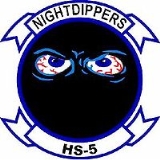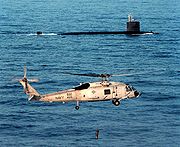
HS-5
Encyclopedia
Helicopter Anti-submarine Squadron Five (HS-5) Nightdippers is a helicopter squadron of the United States Navy
based at Naval Station Norfolk
. The Nightdippers are a part of Carrier Air Wing Seven
and deploy aboard the .
, Florida, on January 3 1956. Its primary mission back then was the same as it is today: denying the enemy effective use of their submarines. In 1963, HS-5 transitioned to the first twin jet-turbine helicopter, the SH-3A "Sea King". In 1978, HS-5 and CVW-7 were assigned to , at the time the Navy's newest nuclear-powered aircraft carrier. Following an extended deployment to the Mediterranean, HS-5 transitioned to the SH-3H, which incorporated the latest in ASW
technological advances.
 An extensive work-up cycle prepared HS-5 and the Eisenhower for a 1988 Mediterranean deployment. With a single helicopter embarked on the USS Peterson (DD 969), the community had its first ever six-month detachment of a single SH-3H for ASW. The venerable "Sea King" again proved its mettle during numerous multi-national exercises and sensitive Black Sea operations. Well-recognized for its outstanding performance in 1988, the squadron reveled its fourth Captain Arnold Jay Isbell Trophy, sixth CNO Safely Award, and a Meritorious Unit Commendation
An extensive work-up cycle prepared HS-5 and the Eisenhower for a 1988 Mediterranean deployment. With a single helicopter embarked on the USS Peterson (DD 969), the community had its first ever six-month detachment of a single SH-3H for ASW. The venerable "Sea King" again proved its mettle during numerous multi-national exercises and sensitive Black Sea operations. Well-recognized for its outstanding performance in 1988, the squadron reveled its fourth Captain Arnold Jay Isbell Trophy, sixth CNO Safely Award, and a Meritorious Unit Commendation
.
Following a successful turnaround cycle highlighted by two successive HSWING ONE Maintenance Trophies, HS-5 deployed to the Mediterranean Sea in March 1990, once again aboard the Eisenhower. Referred to as the "Centennial Cruise" in honor of the 100th anniversary of the birth of President Dwight D. Eisenhower, this deployment included an unusual mid-deployment journey to the English Channel for participation in ceremonies in remembrance of the D-Day invasion of Normandy. In August 1990, the IKE left the Mediterranean again, transiting the Suez Canal and taking position in the Red Sea to deter possible Iraqi aggression against Saudi Arabia at the beginning of Operation Desert Shield.
 The Nightdippers marked the end of an era when the last of their SH-3H "Sea King" helicopters was transferred from NAS Jacksonville in January 1995. Although the Sea Kings were older than the personnel maintaining them, several upgrades, modifications, and service life extensions kept the H-3 up-to-date with the latest technological advances in ASW, electronics, and power plant systems. The squadron kept their vintage helicopters aloft for a total of 108,661 hours and in ready-to-launch, around the clock status for over three decades. The Sea Kings were flown to different parts of the country and one is proudly displayed at the Quonset Point Air Museum in Rhode Island
The Nightdippers marked the end of an era when the last of their SH-3H "Sea King" helicopters was transferred from NAS Jacksonville in January 1995. Although the Sea Kings were older than the personnel maintaining them, several upgrades, modifications, and service life extensions kept the H-3 up-to-date with the latest technological advances in ASW, electronics, and power plant systems. The squadron kept their vintage helicopters aloft for a total of 108,661 hours and in ready-to-launch, around the clock status for over three decades. The Sea Kings were flown to different parts of the country and one is proudly displayed at the Quonset Point Air Museum in Rhode Island
.
January 1995 began a new chapter in Nightdipper history when the squadron transitioned to the H-60
"Seahawk". Faced with completing a demanding transition during a compressed thirteen-month turnaround cycle, the men and women of HS-5 completed the transition three months ahead of schedule and met every operational commitment during their pre-deployment work-up schedule. Also at this time, HS-5 added yet another facet to their repertoire of warfare missions. While detached to NAS Fallon, Nevada, the Nightdippers perfected Combat Search and Rescue (CSAR) procedures in preparation for deployment.
As a result of their first operational deployment with the new SH-60F/HH-60H, the Nightdippers were awarded the COMNAVAIRLANT Battle "E", the Thatch USW Excellence Award and the Commander Sixth Fleet "Hook' em" Award for Undersea Warfare Excellence.
 The squadron has won the prestigious Battle “E” award three of the last five years, and the Fleet Forces Retention Excellence Award for the last two years, as well as the Isbell Award for ASW and ASU excellence in FY06.
The squadron has won the prestigious Battle “E” award three of the last five years, and the Fleet Forces Retention Excellence Award for the last two years, as well as the Isbell Award for ASW and ASU excellence in FY06.
Operationally, recent Nightdipper achievements speak for themselves. Approximately thirty maintainers, aircrew, and pilots from HS-5 were deployed for six months to an Expanded Maritime Interdiction Operation (EMIO) operating site in the summer of 2005. The Nightdippers effectively fulfilled the Navy’s EMIO mission, acting as a critical maritime component to the Global War on Terrorism by deterring, delaying, and disrupting the movement of terrorists and terrorist-related materials at sea. The Nightdippers collaborated on this mission with United States Marine Corps fleet anti-terrorism security teams (FAST) and Mobile Security Squadron Seven (MSS-7), as well as other various allied nations and their forces.
In addition to the recent completion of the EMIO mission, HS-5 provided two aircraft and 37 personnel to participate in the massive Hurricane Katrina relief effort. The Nightdippers logged more than 93.6 flight hours and rescued 41 people in distress, as well as delivering 14,860 pounds of food and water to hurricane victims.
Most recently, HS-5 has provided CVW-7 and the with over 5,000 hours of direct support missions over the course of the 2006 work-up cycle and 2006-2007 extended deployment.
United States Navy
The United States Navy is the naval warfare service branch of the United States Armed Forces and one of the seven uniformed services of the United States. The U.S. Navy is the largest in the world; its battle fleet tonnage is greater than that of the next 13 largest navies combined. The U.S...
based at Naval Station Norfolk
Naval Station Norfolk
Naval Station Norfolk, in Norfolk, Virginia, is a base of the United States Navy, supporting naval forces in the United States Fleet Forces Command, those operating in the Atlantic Ocean, Mediterranean Sea, and Indian Ocean...
. The Nightdippers are a part of Carrier Air Wing Seven
Carrier Air Wing Seven
Carrier Air Wing Seven , is a United States Navy aircraft carrier air wing based at Naval Air Station Oceana, Virginia. The air wing is attached to the aircraft carrier .-Mission:...
and deploy aboard the .
History
Helicopter Antisubmarine Squadron Five was commissioned at Naval Air Station Key WestNaval Air Station Key West
Naval Air Station Key West , is a naval air station and military airport located on Boca Chica Key, four miles east of the central business district of Key West, Florida, United States....
, Florida, on January 3 1956. Its primary mission back then was the same as it is today: denying the enemy effective use of their submarines. In 1963, HS-5 transitioned to the first twin jet-turbine helicopter, the SH-3A "Sea King". In 1978, HS-5 and CVW-7 were assigned to , at the time the Navy's newest nuclear-powered aircraft carrier. Following an extended deployment to the Mediterranean, HS-5 transitioned to the SH-3H, which incorporated the latest in ASW
Anti-submarine warfare
Anti-submarine warfare is a branch of naval warfare that uses surface warships, aircraft, or other submarines to find, track and deter, damage or destroy enemy submarines....
technological advances.

Meritorious Unit Commendation
The Meritorious Unit Commendation is a mid-level unit award of the United States military which is awarded to any military command which displays exceptionally meritorious conduct in the performance of outstanding service, heroic deeds, or valorous actions....
.
Following a successful turnaround cycle highlighted by two successive HSWING ONE Maintenance Trophies, HS-5 deployed to the Mediterranean Sea in March 1990, once again aboard the Eisenhower. Referred to as the "Centennial Cruise" in honor of the 100th anniversary of the birth of President Dwight D. Eisenhower, this deployment included an unusual mid-deployment journey to the English Channel for participation in ceremonies in remembrance of the D-Day invasion of Normandy. In August 1990, the IKE left the Mediterranean again, transiting the Suez Canal and taking position in the Red Sea to deter possible Iraqi aggression against Saudi Arabia at the beginning of Operation Desert Shield.

Rhode Island
The state of Rhode Island and Providence Plantations, more commonly referred to as Rhode Island , is a state in the New England region of the United States. It is the smallest U.S. state by area...
.
January 1995 began a new chapter in Nightdipper history when the squadron transitioned to the H-60
H-60
H-60 is often used as a general name for a wide family of U.S. military helicopters. However, they all use a modified mission symbol in addition to the 'H' vehicle type designator under the 1962 United States Tri-Service aircraft designation system . The mission prefix H-60 is often used as a...
"Seahawk". Faced with completing a demanding transition during a compressed thirteen-month turnaround cycle, the men and women of HS-5 completed the transition three months ahead of schedule and met every operational commitment during their pre-deployment work-up schedule. Also at this time, HS-5 added yet another facet to their repertoire of warfare missions. While detached to NAS Fallon, Nevada, the Nightdippers perfected Combat Search and Rescue (CSAR) procedures in preparation for deployment.
As a result of their first operational deployment with the new SH-60F/HH-60H, the Nightdippers were awarded the COMNAVAIRLANT Battle "E", the Thatch USW Excellence Award and the Commander Sixth Fleet "Hook' em" Award for Undersea Warfare Excellence.

Operationally, recent Nightdipper achievements speak for themselves. Approximately thirty maintainers, aircrew, and pilots from HS-5 were deployed for six months to an Expanded Maritime Interdiction Operation (EMIO) operating site in the summer of 2005. The Nightdippers effectively fulfilled the Navy’s EMIO mission, acting as a critical maritime component to the Global War on Terrorism by deterring, delaying, and disrupting the movement of terrorists and terrorist-related materials at sea. The Nightdippers collaborated on this mission with United States Marine Corps fleet anti-terrorism security teams (FAST) and Mobile Security Squadron Seven (MSS-7), as well as other various allied nations and their forces.
In addition to the recent completion of the EMIO mission, HS-5 provided two aircraft and 37 personnel to participate in the massive Hurricane Katrina relief effort. The Nightdippers logged more than 93.6 flight hours and rescued 41 people in distress, as well as delivering 14,860 pounds of food and water to hurricane victims.
Most recently, HS-5 has provided CVW-7 and the with over 5,000 hours of direct support missions over the course of the 2006 work-up cycle and 2006-2007 extended deployment.
See also
- History of the United States NavyHistory of the United States NavyThe history of the United States Navy divides into two major periods: the "Old Navy", a small but respected force of sailing ships that was also notable for innovation in the use of ironclads during the American Civil War, and the "New Navy", the result of a modernization effort that began in the...
- List of United States Navy aircraft squadrons

